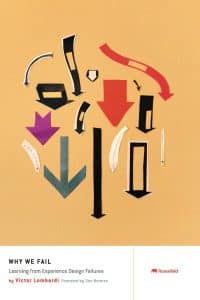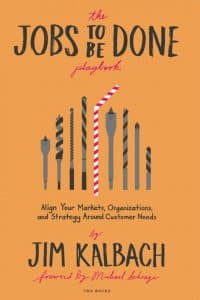Product Management for UX People

From Designing to Thriving in a Product World
User experience designers and researchers often struggle with the idea of product management—as a peer discipline, a job title, a future career, or even what the title entails. But surprisingly, there is no roadmap for designers who want to understand what it takes to manage products and services. At least, not until now.
Enter Christian Crumlish with his book, Product Management for UX People. An experienced product manager himself, Crumlish delves into the intersections and gaps between design and product management—for designers who work with product managers and designers who want to become product managers. You’ll find all the answers to your questions about this intriguing career.
Who Should Read This Book
UX professionals who are curious about product management and want to know which of their skills might apply to the products role if they are considering a career change. Any UX person who works on a product team and wants to figure out how best to work in that context. A UX practitioner or manager who is considering a transition to product management and needs guidance about the responsibilities and career possibilities.
Takeaways
- Define what product management means for your business and what product managers actually do.
- Apply your skills as a UX practitioner to the product manager role.
- Learn how product managers work with engineers to keep teams aligned and take responsibility for business outcomes.
- Figure out how product managers, UX practitioners, and teams can work together effectively.
- Pinpoint how to say “no” to stakeholders and make difficult choices between competing priorities
- Read compelling stories about the author’s experiences, as well as other people’s stories in “From the Trenches” sidebars.
- Be sure to read the “44 Signs You Are Becoming a ‘Real’ Product Manager.”
- Figure out how best to work with data analytics for growth, engagement, and retention in your business.
- Learn how to test hypotheses with real-world experiments.
- Discuss profit and loss models, revenue models, and how to break even.
- Look for “Key Insights” at the end of each chapter, which highlight the important points to remember.
User experience designers and researchers often struggle with the idea of product management—as a peer discipline, a job title, a future career, or even what the title entails. But surprisingly, there is no roadmap for designers who want to understand what it takes to manage products and services. At least, not until now.
Enter Christian Crumlish with his book, Product Management for UX People. An experienced product manager himself, Crumlish delves into the intersections and gaps between design and product management—for designers who work with product managers and designers who want to become product managers. You’ll find all the answers to your questions about this intriguing career.
Who Should Read This Book
UX professionals who are curious about product management and want to know which of their skills might apply to the products role if they are considering a career change. Any UX person who works on a product team and wants to figure out how best to work in that context. A UX practitioner or manager who is considering a transition to product management and needs guidance about the responsibilities and career possibilities.
Takeaways
- Define what product management means for your business and what product managers actually do.
- Apply your skills as a UX practitioner to the product manager role.
- Learn how product managers work with engineers to keep teams aligned and take responsibility for business outcomes.
- Figure out how product managers, UX practitioners, and teams can work together effectively.
- Pinpoint how to say “no” to stakeholders and make difficult choices between competing priorities
- Read compelling stories about the author’s experiences, as well as other people’s stories in “From the Trenches” sidebars.
- Be sure to read the “44 Signs You Are Becoming a ‘Real’ Product Manager.”
- Figure out how best to work with data analytics for growth, engagement, and retention in your business.
- Learn how to test hypotheses with real-world experiments.
- Discuss profit and loss models, revenue models, and how to break even.
- Look for “Key Insights” at the end of each chapter, which highlight the important points to remember.
Testimonials
Whether you’re a designer considering a career change, or simply want to understand your product managers better, this book is an exceptional guide to the unique challenges of the product craft. Designers and product people have some clear overlaps—but also key differences. In this excellent book, Christian helps distinguish the two roles, succinctly breaks down the unique challenges of the product craft, and explains what it means to transition from one to the other—and in so doing, helps us all understand each other better.
Martin Eriksson, co-author, Product Leadership, and co-founder and chairman, Mind the Product
Filled with wisdom from Crumlish and other experts on the business aspects of product development, this book teaches UX designers what to expect from PMs and encourages them to become one.
Peter Boersma, DesignOps manager, Miro
Christian lights the way for folks in UX to successfully navigate the world of product management. A must-read for any serious UX practitioner.
Clement Kao, CEO, product teacher
Finally, a book that zooms into the Venn diagram between product management and UX with day-in-the-life clarity.
Hà Phan, UX designer turned Director of Product
I’m so bloody excited about this book. At last, a definitive guide to demystifying product management (and product managers) for UX folk. Christian has nicely bridged a gap that will improve your collaboration to deliver the best-designed products and services.
Jared Spool, Maker of Awesomeness, Center Centre – UIE
Too few books think through the synergies as well as complexities of transitioning from UX to product. Christian’s book explores those nuances and provides a straightforward roadmap of what skills translate and where there are opportunities to learn a great deal more
B. Pagels-Minor, product and thought leader
This is the book to read if you’re thinking of a career transition from UX to product. You’ll find out more about what you’ll get (decision-making power) and what you’ll lose (your idealism and purity).
Ellen Chisa, Founder in Residence, Boldstart Ventures
Table of Contents
Foreword by Matt LeMay
Chapter 1: What Exactly Does a Product Manager Do?
Chapter 2: Do You Want to Be a Product Manager?
Chapter 3: UX Skills that Carry Over
Chapter 4: Wrangling Engineers
Chapter 5: The Business of Product is Business
Chapter 6: Product Analytics: Growth, Engagement, Retention
Chapter 7: Testing Hypotheses with Experiments
Chapter 8: Getting the Money
Chapter 9: Healthy Collaborative Tension on the Product UX Spectrum
Chapter 10: Roadmaps and How to Say “No”
Chapter 11: Chief Information Architect
FAQ
These common questions and their short answers are taken from Christian Crumlish’s book Product Management for UX People: From Designing to Thriving in a Product World. You can find longer answers to each in your copy of the book, either printed or digital version.
- Can I become a product manager and continue to do a lot of design work every day?
Unlikely. Maybe in a small start-up where they need you to do two jobs at once, but product managers are not designers and the day- to-day work of the two roles differs significantly, as explained in Chapter 2, despite the large overlapping areas of shared concern.
Sample Chapter
This is a sample chapter from Christian Crumlish’s book Product Management for UX People: From Designing to Thriving in a Product World. 2022, Rosenfeld Media.
Chapter 1: What Exactly Does a Product Manager Do?
If you’re not sure what product managers do, you’re not alone. Quite a few hiring managers—not to mention entire businesses—are also confused about this job title and what exactly it means. It doesn’t help that there are a wide variety of legitimate approaches to product management that tend to emphasize one or another of the constituent proficiencies at the expense of the others. As confusing as this may seem, there are multiple legitimate approaches to product management in practice today, because the work itself depends so heavily on context. That being said, every product manager has the same core responsibility: value.













